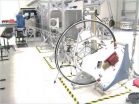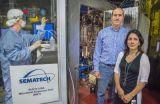(Press-News.org) A significant percentage of completed drug clinical trials, especially those funded by industry, are not disclosed to the public, years after being completed—a trend that "threatens the validity of the clinical research literature in the U.S.," according to a study led by a Boston University School of Public Health (BUSPH) researcher.
The study, published in the journal PLOS ONE, found that close to 30 percent of 400 randomly selected clinical trials completed in 2008 had not resulted, four years later, in either publication in a journal or the posting of results to the ClinicalTrials.gov (CTG) web site.
Studies that were funded solely by industry, or that involved smaller sample sizes, were less likely to be published, the research shows.
The study's lead author, Dr. Christopher Gill, director of BUSPH's Pharmaceuticals Program and an associate professor of global health, said the review raises ethical, as well as scientific, problems.
"Individuals who volunteer for clinical trials often do so out of a sense of altruism," said Gill, a researcher with BU's Center for Global Health and Development. "I can imagine that many would be dismayed to learn that the results of a study that they participated in, that they took physical risks for, might never generate results known beyond the company that sponsored the trial.
"Science learns from mistakes, as well as successes," he said. "If we only learn about the scientific success stories, we are really only seeing part of the picture."
Gill and a former student, Hiroki Saito, found that 118 of the 400 clinical trials did not result in publication within four years of completion. The median length of time from completion to public disclosure was 602 days.
Among industry-funded studies, rates of posting to the CTG site were high for phase 3 or 4 studies, but extremely low for phase 2 studies.
"As an overall synthesis, these findings provide strong evidence of reporting bias," Gill and Saito wrote. They said the associations between publication or posting rates and funding sources "merit further consideration, and may reflect differing motivations" among researchers.
Among academics working under a "publish or perish" model, and who represent the majority of non-industry funded studies, the study phase "may be less critical than the need to publish research findings in journals," Gill and Saito said. By contrast, the pharmaceutical industry may publish more results for products that have advanced to phase 3 or beyond and are perceived to be commercially viable.
Gill and Saito suggested that regulatory requirements could be driving the differences in rates of posting results to the CTG. Among industry-funded, phase 3 or 4 studies, the majority of researchers posted their results at about one year from completion—coinciding closely with a one-year deadline established in 2007 by the Food and Drug Administration Amendments Act (FDAAA).
Regardless of the reasons, Gill and Saito said, transparency in clinical trials is "an essential public health good. The public must be informed if the premise of a clinical trial was confirmed or invalidated, and expects that, once a study involving human subjects is completed, its results will be published in the medical literature or posted to some other open-access platform."
They said that in order to maintain the public's faith in clinical research, and to protect the fidelity of the scientific literature, "it is essential that the research community unite around the common goal of maximizing transparency. "
In 2012, Gill reported that among US-based, industry-funded phase 2 or higher clinical studies, less than 25 percent had posted their results to CTG within a year of completion. Another study found that, among National Institutes of Health-funded trials, 32 percent remained unpublished after the median follow-up of 51 months from completion.
INFORMATION:
Transparency lacking in clinical trials, BU study finds
2014-07-15
ELSE PRESS RELEASES FROM THIS DATE:
Do women talk more than men? It's all about context
2014-07-15
We've all heard the stereotype: Women like to talk. We bounce ideas off each other about everything from career moves to dinner plans. We hash out big decisions through our conversations with one another and work through our emotions with discussion.
At least, that's what "they" say. But is any of it actually true? A new study from Northeastern University professor David Lazer's lab says it isn't that simple.
Lazer, who researches social networks and holds joint appointments in the Department of Political Science and the College of Computer and Information Sciences, ...
NASA's Van Allen Probes show how to accelerate electrons
2014-07-15
One of the great, unanswered questions for space weather scientists is just what creates two gigantic donuts of radiation surrounding Earth, called the Van Allen radiation belts. Recent data from the Van Allen Probes -- two nearly identical spacecraft that launched in 2012 -- address this question.
The inner Van Allen radiation belt is fairly stable, but the outer one changes shape, size and composition in ways that scientists don't yet perfectly understand. Some of the particles within this belt zoom along at close to light speed, but just what accelerates these particles ...
NOAA's GOES-R satellite Magnetometer ready for spacecraft integration
2014-07-15
The Magnetometer instrument that will fly on NOAA's GOES-R satellite when it is launched in early 2016 has completed the development and testing phase and is ready to be integrated with the spacecraft.
The Magnetometer will monitor magnetic field variations around the Earth and enable forecasters at NOAA's Space Weather Prediction Center to better predict the consequences of geomagnetic storms. These storms pose a threat to orbiting spacecraft and human spaceflight. In addition, the measurements taken by the Magnetometer will aid in providing alerts and warnings to power ...
For bees and flowers, tongue size matters
2014-07-15
For bees and the flowers they pollinate, a compatible tongue length is essential to a successful relationship. Some bees and plants are very closely matched, with bee tongue sized to the flower depth. Other bee species are generalists, flitting among flower species to drink nectar and collect pollen from a diverse variety of plants. Data on tongue lengths can help ecologists understand and predict the behavior, resilience and invasiveness of bee populations.
But bee tongues are hard to measure. The scarcity of reliable lingual datasets has held back research, so Ignasi ...
Study finds why some firms are 'named and shamed' by activists
2014-07-15
COLUMBUS, Ohio – A new study of the anti-sweatshop campaigns of the 1990s reveals which companies are most likely to become targets of anti-corporate activists.
Researchers found that companies tended to attract the attention of labor activists if they were large, had prominent brand images, or had good corporate reputations. When combined, these factors were especially important.
"Companies that had all of these characteristics were nearly guaranteed to be a target of activism," said Tim Bartley, lead author of the study and associate professor of sociology at The ...
Fundamental chemistry findings could help extend Moore's Law
2014-07-15
Over the years, computer chips have gotten smaller thanks to advances in materials science and manufacturing technologies. This march of progress, the doubling of transistors on a microprocessor roughly every two years, is called Moore's Law. But there's one component of the chip-making process in need of an overhaul if Moore's law is to continue: the chemical mixture called photoresist. Similar to film used in photography, photoresist, also just called resist, is used to lay down the patterns of ever-shrinking lines and features on a chip.
Now, in a bid to continue decreasing ...
Study: Body Dysmorphic Disorder patients have higher risk of personal and appearance-based rejection sensitivity
2014-07-15
PROVIDENCE, R.I. – In a recent study, researchers at Rhode Island Hospital found that fear of being rejected because of one's appearance, as well as rejection sensitivity to general interpersonal situations, were significantly elevated in individuals with Body Dysmorphic Disorder (BDD). These fears, referred to as personal rejection sensitivity and appearance-based rejection sensitivity, can lead to diminished quality of life and poorer mental and overall health. BDD is a common, often severe, and under-recognized body image disorder that affects an estimated 1.7 to 2.4 ...
Prostate cancer in young men -- More frequent and more aggressive?
2014-07-15
ANN ARBOR, Mich. -- The number of younger men diagnosed with prostate cancer has increased nearly 6-fold in the last 20 years, and the disease is more likely to be aggressive in these younger men, according to a new analysis from researchers at the University of Michigan Comprehensive Cancer Center.
Typically, prostate cancer occurs more frequently as men age into their 70s or 80s. Many prostate cancers are slow-growing and many older men diagnosed with early stage prostate cancer will end up dying from causes other than prostate cancer.
But, the researchers found, ...
Rollout strategy for diagnostic test in India may impact TB
2014-07-15
Xpert MTB/RIF, a recently implemented tuberculosis (TB) test, has the potential to control the TB epidemic in India, but only if the current, narrow, implementation strategy is replaced by a more ambitious one that is better funded, also includes the private sector, and better referral networks are developed between public and private sectors, according to new research published in this week's PLOS Medicine. The study by David Dowdy, from Johns Hopkins University, United States, and colleagues is a mathematical model that suggests alternative strategies that include engagement ...
Molecular 'eat now' signal makes cells devour dying neighbors
2014-07-15
A team of researchers has devised a Pac-Man-style power pellet that gets normally mild-mannered cells to gobble up their undesirable neighbors. The development may point the way to therapies that enlist patients' own cells to better fend off infection and even cancer, the researchers say.
A description of the work will be published July 15 in the journal Science Signaling.
"Our goal is to build artificial cells programmed to eat up dangerous junk in the body, which could be anything from bacteria to the amyloid-beta plaques that cause Alzheimer's to the body's own ...





